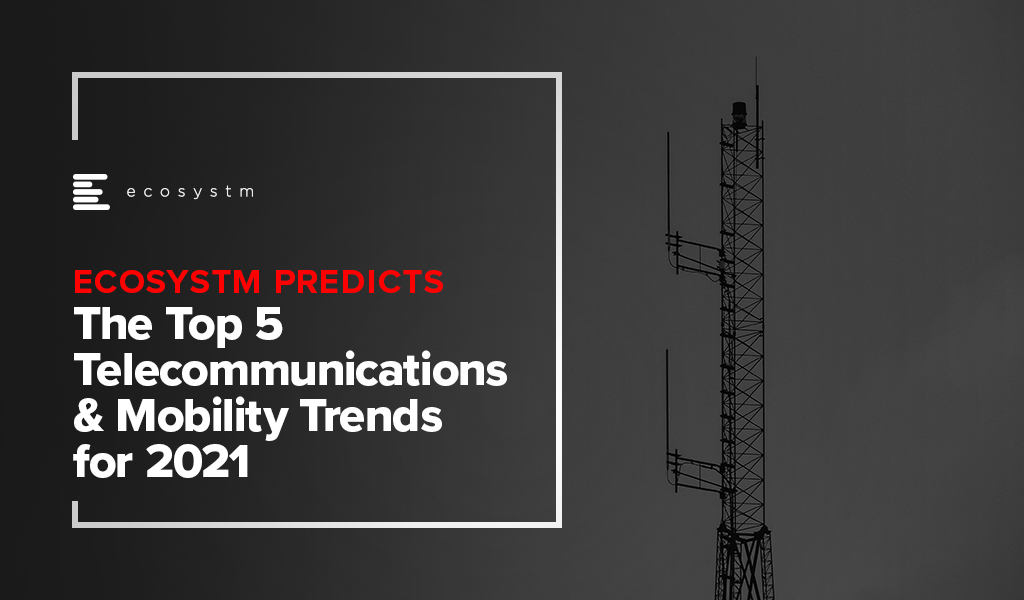
As we move into a new decade, the Telecommunications industry is ripe for disruption, as it gets reshaped by bountiful bandwidth and software enabled flexibility. Several countries have spent the last decade building fibre access networks. 5G is expected to lower latency and provide greater flexibility. As virtualisation, AI and automation combine to make networks even more cost effective it will broaden use cases to include widespread adoption of IoT.
The Top 5 Telecommunications and Mobility Trends for 2020
Below are the top 5 Telecommunications and Mobility Trends for 2020. It is based on the latest data from the global Ecosystm Mobility Study and is based on qualitative research by Liam Gunson, Director, Product and Solutions at Ecosystm.
-
50 Shades of 5G
In 2020, 5G will be a major step change in what a mobile network can do – in terms of capacity, efficiency, stability, and latency. The amount of money and investment associated with it will also keep it in the spotlight. The year will see 5G move beyond trials to actual commercial rollouts – but that will also mean more regulations and a competitive landscape. There will be multiple deployment models:
- In fixed vs mobile markets, the most obvious choice will be to take a share of the home broadband space first
- Markets with strong growth in data usage and higher ARPUs will evolve 4G to provide higher bandwidth while looking to 5G for their economic benefits in efficiently managing spectrum
- In other areas, operators will be forced to explore spectrum or infrastructure sharing to spread costs across lower ARPUs or align with regulators’ desire to limit licenses. This is likely to be more common in emerging markets and low-density areas.
-
Enterprise Mobility Will Witness a Renaissance
Enterprise mobility will be back on IT teams’ agenda after having taken a backseat for a few years. Ecosystm research shows that over 72% of organisations have a Mobile First strategy. This is set to accelerate for a number of reasons:
- Companies are increasingly adopting agile or new ways of working to speed up innovation and delivery – and this includes working in new teams and activity-based working
- As more millennials and the Gen Z enter the workforce, there will be a steady rise of the ‘gig economy’ and a high percentage of contract, part-time and freelance workers
- As organisations become more agile and the workforce increasingly mobile there will be a bigger drive towards space optimisation, seeing a higher adoption of shared offices and co-working spaces
-
The Future of the LAN is Cloudy
The next few years will see a re-think of the traditional LAN/WAN set-up, as user needs change with Digital Transformation (DX) initiatives, and new technologies such as GPON, 5G, Wifi 6, WiGig, and software-defined networking bring new capabilities and alter costs. Enterprise network will change in the following ways:
- Wireless connectivity will move beyond BYOD and guest access and become the primary connection type – the connection points will be sensors and access points, and not PCs
- AI, virtualisation and software-defined networking will bring more flexibility as they lessen the need for specialised hardware, centralise control, and speed up configuration changes
- Enterprises will stop thinking of their network as a physical space and start seeing it as a set of capabilities. Equipment will be increasingly centralised in data centres (possibly on the Edge) to allow workers to work from virtually anywhere.
-
Intelligence at the Edge – from Connected Things to Conscious Things
We have moved past step 1 of IoT, where the focus was on making sensors and chipsets cheap enough to be incorporated in millions of different devices, as well as a to find cost-effective ways to handle the data requirements. 2020 will see IoT move to step 2 – from sensing to responding. AI will become easier to develop and use, while edge compute, high-bandwidth, and low latency networks will make it possible to be embedded into an expanding number of use cases where devices and processes need to make real-time adjustments.
This will become most obvious as we see an increased use of cameras as sensors. With their ability to capture details, they are the most effective sensors we can have. The challenge has been that high definition video is incredibly data heavy, creating issues when trying to transport and analyse it. Edge compute will help to bring the analytics closer to the source lowering the transport costs, while also lowering latency and increasing security.
-
Expansion Drives Consolidation
Telecommunications operators have been evolving for a while now using measures such as acquiring new companies, establishing disruptive business units and so on. In 2020, these operators will focus on transforming the core – remove unnecessary costs, improve customer experience, capture new opportunities – and on building telecom networks with scalability, flexibility, efficiency and agility.
As providers become more flexible, they will not only be easier to integrate with, but will also be able to manage more products and niche requirements. Traditionally 80-90% of their revenues have come from consumers and Telecommunications providers own these relationships. Now they will have to start working on their B2B relationships.
Ultimately the network game will be one of scale, and this will force operators to consolidate to survive. Nokia Bell Labs expects global operators to fall from 10 to 5 between 2020 and 2025, and local operators to fall from 800 to 100 – this looks completely plausible at the moment.
Download Report: The top 5 Telecommunications & Mobility Trends For 2020
The full findings and implications of the report ‘Ecosystm Predicts: The Top 5 Telecommunications & Mobility Trends For 2020’ are available for download from the Ecosystm platform. Signup for Free to download the report and gain insight into ‘the top 5 Telecommunications & Mobility Trends For 2020’, implications for tech buyers, implications for tech vendors, insights, and more resources. Download Link Below ?







